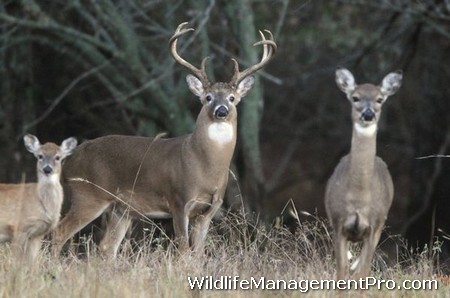The management of white-tailed deer populations takes place across most of the US, where whitetail range. Whitetail numbers are monitored for several reasons. First of all, deer can negatively impact the habitat in which they live if they become overabundant, i.e too many. This is a bad situation for the deer, the plant communities found there as well as other wildlife species that require those plants/habitat. Many suburban management programs aim to keep deer at a healthy numbers for the area.
In addition, deer hunting pumps millions of dollars into the US economy in rural areas each year, and demand for deer hunting lands continues to grow. Additionally, an increasing number of landowners are realizing the potential income from managing the deer found on their properties. Many have capitalized of the demand for big, healthy deer by practicing deer management programs on their properties. This involves managing both the wildlife populations and the habitat found there over many, many years.
The whitetail is one of the more adaptable large mammal species found in North America. With minimal protection and adequate food, deer thrive over a wide array of land-use types and, often, close to urban centers. Deer habitats are composed of different quantities and qualities of food, cover, water and some amount of space. The number of deer that can be supported in good physical condition on any given land area is called the carrying capacity of that habitat.
Food: Key Ingredient for Deer Management
White-tailed deer require an abundance and variety of nutritious foods for growth, reproduction, and maintenance. The amount and nutritional content of available food will affect deer productivity, health, size, and even antler growth. On the average, a deer eats 4 to 6 or more pounds of food daily for each 100 pounds of body weight. Food items must be from ground level to 4-1/2 feet high to be available to deer. During a year, one deer may eat more than a ton of food!
Deer have been known to eat thousands of different food items. Generally, food is selected according to its availability, nutritional value, and overall palatability. The preferred food of deer varies from area to area and changes throughout the year. Deer readily eat many forb and browse species. Legumes are extremely good deer foods.
During spring through early fall, deer eat succulent grasses, legumes, weeds, fleshy fruits, assorted agricultural crops, and the tender growth of shrubs, trees, and vines. During fall and winter, their diet shifts to acorns, evergreen leaves, succulent green growth of small grains, and stems of many woody plants. Tender, palatable stems of vines and trees are useless, regardless of their abundance, if they are out of reach for deer.
Whitetail Deer Management Takes Habitat
Whitetail can inhabit a variety of sites, but the areas providing the best cover include an even mixture of mature hardwoods, croplands, brushlands, and pasturelands. An uneven aged woodland with scattered openings is best since it produces an abundance of succulent vegetation within easy reach of browsing deer. Such an area also provides plenty of resting and bedding room. Many properties involved in the management of deer strive to provide all of these communities through active habitat management.
Although deer get some water by eating succulent foods, they require free water for drinking almost daily. Streams, ponds, and other wet areas are used regularly for drinking. Access to water does not limit deer in the Easter US, but does further west. During periods of drought, however, water may influence the habitat they use in just about any part of their range.
Deer Herd Management
White-tailed deer herds are managed primarily by selective removal during the deer hunting season. Unlike other game animals, deer have few natural predators to keep populations in check. Sport hunting takes the place of natural predators. If unhunted or lightly hunted, deer increase rapidly until their numbers exceed available food supplies. As this occurs, preferred foods are eliminated, herd productivity is reduced, and the health and size of the animals begin to decline.
Continued population increases often cause long-term habitat destruction. The incidence of disease and parasites increases. Ultimately, natural mortality rises and, occasionally, widespread die-offs occur.
Once a deer population reaches the carrying capacity of the habitat, the growth must be stabilized. About 35 percent of a deer population must be removed annually to stabilize the population. Intensive buck-only hunting rarely removes more than 10 to 15 percent of a population. Removing significant numbers of does is necessary to keep a deer herd from becoming overpopulated.
Many sport hunters are interested in increasing their opportunities for taking trophy bucks. As such, many private landowners are interested in habitat and deer management to grow bigger bucks on their properties. Such objectives demand that deer populations be reduced enough to ensure that adequate nutrition is available for good body and antler growth. Hunters and landowners must also be willing to conserve younger age classes of bucks and allow them to reach potential trophy age (4 to 7 years).
Habitat Management for Healthy Deer
The capability of land to support white-tailed deer is influenced largely by vegetation types and condition, soil productivity, and weather patterns. Land may be manipulated to increase the number of deer it can sustain and to improve nutritional plants for existing populations. Ideally, a mixture of habitat types, over relatively small areas, should be provided for deer. Several land and forest management techniques are also great practices for deer habitat management. They include prescribed burning, timber thinning, food plantings, and fertilization programs, among others.
